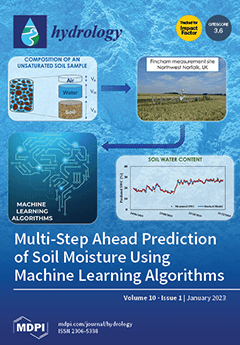Point and nonpoint wastewater sources have a detrimental, negative effect on agriculture, soil, surface, and groundwater supplies. In this research, a wastewater treatment system made up of a sedimentation tank, a horizontal subsurface flow constructed wetland (HSSF-CW), a vertical subsurface flow constructed wetland
[...] Read more.
Point and nonpoint wastewater sources have a detrimental, negative effect on agriculture, soil, surface, and groundwater supplies. In this research, a wastewater treatment system made up of a sedimentation tank, a horizontal subsurface flow constructed wetland (HSSF-CW), a vertical subsurface flow constructed wetland (VF-CW), and a storage tank was proposed, designed, and cost estimated. Small populations in underdeveloped nations with dry and semi-arid climates can use the treatment system as an affordable construction, maintenance, and operational solution for wastewater treatment. The system will protect agricultural lands and groundwater from pollution. The system can service 6000 capita and has a wastewater discharge of 780 m
3/d in the developing arid region in El-Moghra Oasis western desert of Egypt, where the 1.5 million acres used for the land reclamation project based on groundwater irrigation. The relaxed tanks in a series model based on the areal loading rates and background pollutants concentrations (P-K-C*) was utilized to size the HSSF and VF-CWs. The results indicated that the HSSF-CW design treatment surface area was 2375 m
2, and the hydraulic surface loading (q) and hydraulic retention time (RT) were 0.33 m/d and 0.55 d, respectively, and utilizing Phragmites australis and Papyrus for the biological treatment. The expected overall cumulative removal efficiencies were 96.7, 70, and 100% for the biological oxygen demand (BOD), total phosphors (TP), and fecal coliforms (FC), respectively. The VF-CW indicates that there was a 2193 m
2 design treatment surface area,
q = 0.36 m/d, and RT of 0.63 d. The expected BOD, TP, and FC removal efficiencies were 75, 33.3, and 92.7%, respectively. In order to simplify the design stages and the cost estimation, design and investment cost curves were established for a population range from 500 to 9000. The total monthly water loss due to evapotranspiration for the HSSF and VF-CWs indicates a range from 3.7 to 8.5%, respectively. The total investment cost analysis for the proposed system corresponding to 780 m
3/d wastewater discharge of indicates a total investment cost of EUR 146,804 and EUR 24.46/per-capita equivalent (P.E). This approach can be used by decision makers in the Mediterranean region and Middle Eastern countries to improve the water quality using social and economic criteria, leading to the effective implementation of ecological restoration projects as a low-cost treatment system and adding a nonconventional water source that can be used in irrigation.
Full article





